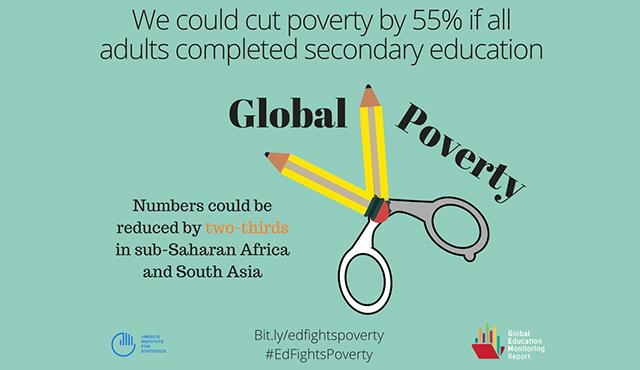World Poverty Could Be Cut in Half if All Adults Completed Secondary Education
Share
19/06/2017

New data on out-of-school children and youth
A new policy paper released jointly by the UNESCO Institute for Statistics (UIS) and the Global Education Monitoring (GEM) Report shows that the global poverty rate could be more than halved if all adults completed secondary school. Yet, new UIS data show persistently high out-of-school rates in many countries, making it likely that completion levels in education will remain well below that target for generations to come.
The paper, Reducing global poverty through universal primary and secondary education, is being released ahead of the UN High Level Political Forum (10-19 July), which will focus on poverty eradication in pursuit of the 2030 Agenda for Sustainable Development. The paper demonstrates the importance of recognizing education as a core lever for ending poverty in all its forms, everywhere.
The new analysis on education’s impact on poverty by the GEM Report is based on the average effects of education on growth and poverty reduction in developing countries from 1965 to 2010. It shows that nearly 60 million people could escape poverty if all adults had just two more years of schooling. If all adults completed secondary education, 420 million could be lifted out of poverty, reducing the total number of poor people by more than half globally and by almost two-thirds in sub-Saharan Africa and South Asia.

No progress in reducing out-of-school rates
Despite education’s potential, new UIS data show that there has been virtually no progress in reducing out-of-school rates in recent years. Globally, 9% of all children of primary school age are still denied their right to education, with rates reaching 16% and 37% for youth of lower and upper secondary ages, respectively. In total, 264 million children, adolescents and youth were out of school in 2015.
Sub-Saharan Africa remains the region with the highest out-of-school rates for all age groups: more than half (57%) of all youth between the ages of 15 and 17 are not in school as are more than one-third (36%) of adolescents between 12 and 14 years and one-fifth (21%) of children between the ages of about 6 and 11. Six countries are home to more than one-third of all out-of-school children of primary age: Ethiopia, India, Indonesia, Nigeria, Pakistan and Sudan.
Of the 61 million children of primary school age currently out of school, 17 million will never to set foot in a classroom if current trends continue. This affects one in three children out of school in sub-Saharan Africa, Western Asia and Northern Africa, and more than one in four of those in Central Asia and Southern Asia.
Girls in poor countries continue to face particularly steep barriers to education. According to UIS data, in low-income countries, more than 11 million girls of primary age are out of school, compared to almost 9 million boys. The good news is that the girls who do manage to start school tend to complete the primary cycle and pursue their studies at the secondary level.